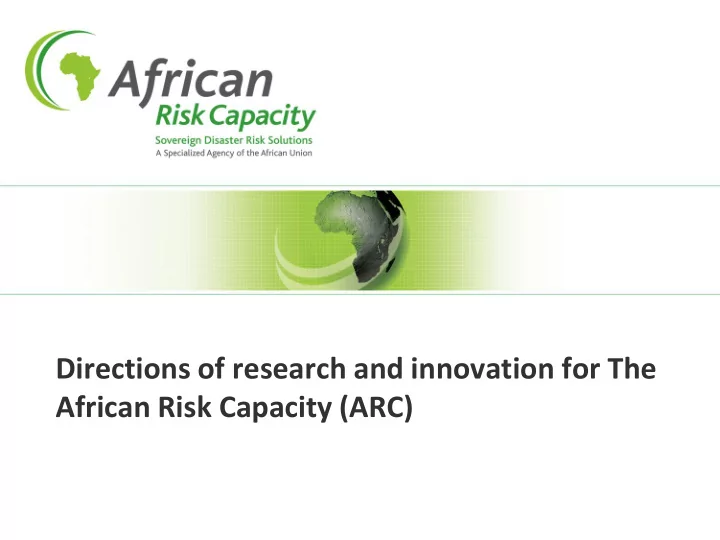

Directions of research and innovation for The African Risk Capacity (ARC)
ARC’s Structure Governed by Member States
Savings from Early Intervention Uses Africa RiskView to estimate and trigger immediate resources to governments in the case of a disaster. Cost-effective contingency funding protects livelihoods and development gains
Africa RiskView : Quantifying the Risk Africa RiskView (ARV) is the software application developed to underpin ARC Ltd’s index-based drought insurance contracts Hazard Satellite-based rainfall data for over 261,000 satellite pixels over Africa (0.1 dg x 0.1 dg or 10 x 10km sq. near the equator) updated every 10 days. Current focus is drought with a flood model in development. Vulnerability Who ’ s at risk? Where are they? What are they growing or where do their herds graze? Exposure In today ’ s procurement and logistic costs, how much will it cost to assist each potential person affected?
Research focus: improving Africa RiskView SAFARI Research project International collaboration with NDMA Kenya, Agrhymet, Imperial college of London, ILRI, WFP and ARC Objective: Improve the accuracy of the model 1. Toolkit and assessment of rainfall satellite (inc. CHIRP and CHIRPS with Colombia university) 2. Realtime evapotranspiration (better capture the impact of temperature) 3. Revisit the drought model (WRSI / VCI) Robustness and sensitivity analysis Multi Hazard , e.g. flood and excess rainfall
Innovation: Licencing for development Maximizing the use of Africa RiskView: licencing the software to meso actors. Crowd in the local insurance sector Facilitate loans to the agriculture sector by providing a risk tool Encouraging meso level index insurance Challenges: marketing cost – training - education
Innovation: The Extreme Climate Facility (XCF) • The case of Niger • If the frequency and intensity of extreme weather events increases • Based on an objective, multi-hazard Extreme Climate Index (ECI) and focus on each climatological region of Africa
XCF Illustration ECI Graphic Key: Payment of $220m/Country Multi-Hazard Extreme Climate Index (ECI) Payment of $30m/Country XCF Payment Trigger Accruing ECI Events per Country*: Payment of $190m/Country; attachment level moves $5m/ECI Unit $10m/ECI Unit $15m/ECI Unit $20m/ECI Unit Payment Released at end of 5-Yr Financing Window *Unit payout size increases with each trigger event, growing with the increasing confidence that the climate is changing
Niger XCF Start Date: 1950 ( with 5-yr financing Premium % Estimate windows) ARV Modelled Drought Response Costs • Red bars denote likely XCF payouts as a result of extreme events particularly 1973, ‘74, ’83, ‘84 and ’87 • Payouts would have increased in size as multiple extreme dry events were experienced and certainty in the changing climate grew
Mechanism Illustration of possible XCF ARC Agency: funds flow over a five-year Gateway for Country Region 1 financing window: Country 1 Participation Country 2 Country 3… Risk & Region 2 Payments to Region if Country 1 XCF Capital Payments to Region if Triggering ECI Event Occurs Country 2 Triggering ECI Event Occurs Markets Country 3… Risk Transfer Cost (Paid by Region 3… Donors) Country 1 Country 2 Country 3…
Eligibility If triggered, XCF payments will be released to countries only with climate adaption plans approved by ARC Agency’s Peer Review Mechanism (PRM) • ARC Member States that are actively managing their weather risk • With climate adaptation plans approved by ARC Agency Peer Review Mechanism • The critical questions to be addressed: What would be the most effective use of XCF funds? How should they be prioritised to a) reduce household vulnerability, b) build meaningful, effective national resilience and c) lead to affordable ARC Ltd premiums? • To be effective, XCF’s climate adaptation plan standards should align with and build on on-going work in climate adaption and ARC will need to partner with existing initiatives
Thank You Website: www.africanriskcapacity.org Twitter: @ARCapacity
Recommend
More recommend